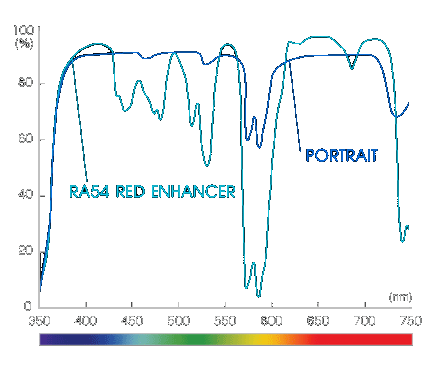Equipment Review
Hoya RA54 Red Enhancer (Light Pollution Filter)
For camera lenses with 49, 52, 55, 58, 62, 67, 72, 77, 82 mm threads.
NOTE: In America the brand is 'HOYA INTENSIFIER', in other countries it is 'HOYA RA54 RED ENHANCER'. The product is the same.
Please appreciate that this review reflects personal impressions and views.

Manufactured in Japan by Kenko Tokina/Hoya this filter, made of "didymium" (a rare earth material), enhances the colors red and orange, thus filtering out light pollution for astro-photography. Compared with other solutions the Hoya filter is reasonably priced at US$ 22.00 for the smallest 49mm and US$ 120.00 for the largest 82mm thread size (as of Dec 2018) and is specified to filter out wavelengths from about 575nm to 600nm, the color of most sodium vapor lamps (conventional street lamps) responsible for light pollution. In daylight photography the filter enhances reddish colors, say, that of autumn leaves.

- Filter medium: didymium glass
- Filter density: 0.15
- Filter factor: 1.5x
- Exposure compensation: +1/2 stop
- Blocked band: λ575 - 600nm
- Ring material: aluminum-alloy
- Manufactured in: Japan
Since pictures tell more than words actual examples showcase the most welcome effect of the filter. One does not need to be a specialist to recognize that this filter performs an efficient job under light polluted skies, saving time and aggravation during image post-processing. The low light transmission loss (filter factor 1.5 = +1/2 f/stops) can be compensated for with a few more seconds of exposure. No big issue. The results demonstrate the distinct benefit of the filter for the background of the stars.
Pleiades
Single frames, both 30 seconds at ISO 800, unprocessed. White balance set to daylight. Nikon D5300 with 135mm F1:2.8 lens, guided on Vixen Polarie. Diffraction of bright stars generated with a Kenko R-Cross Screen filter (a must for beautiful constellation photos). The horizontal FOV is about 5° (cropped from original 10° wide frame).


Constellation Orion
Single frames, both 20 seconds at ISO 1600, unprocessed out of the camera. White balance set to daylight. Nikon D5300 with 28mm F1:2.8 lens, guided on Vixen Polarie. The horizontal FOV is about 45°.


Orion's Nebulae
A stack of 88 frames 30 seconds each at ISO 800 with the HOYA Filter on a Samyang 135mm lens stopped at f4 on a Nikon D5500, guided on StarAdventurer. The horizontal FOV is about 10°.

Pros
- Efficiently reduces the effect of background glow
- Low light transmission loss
- Helps emphasize red nebulae
- Absence of unwanted straylight
- Well crafted (Made in Japan)
- Affordable, low price
Cons
There are no cons that originate from the product.
- No anti-reflective coating (cost limitation)
- Sacrifices light transmission (physical limitation)
- Makes you wish to have one more for your refractor lens.
Conclusion
By all means, this is a must-have for skyscape and deepsky photographers alike. Excellent cost-performane ratio, tangible effects (exceeds advertisement).
Further Reviews

